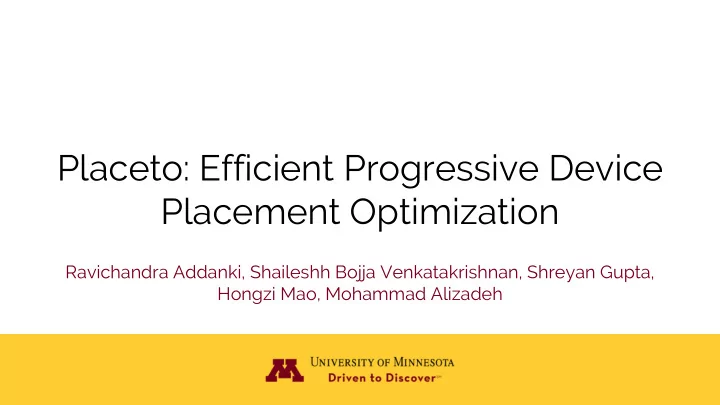

Placeto: Efficient Progressive Device Placement Optimization Ravichandra Addanki, Shaileshh Bojja Venkatakrishnan, Shreyan Gupta, Hongzi Mao, Mohammad Alizadeh
Recall--- What is Device Placement G(V,E): the computational graph of a neural network ● D: a set of devices (e.g., CPUs, GPUs) ● ● Ⲡ : V -> D ● p(G, ⲡ ): the duration of G’s execution when its ops are placed according to ⲡ Goal: find a placement ⲡ that minimizes p(G, ⲡ ) ●
Recall --- Why need Device Placement Trend toward many-device training, bigger models, larger batch sizes ● Growth in size and computational requirements of training and inference ●
Recall --- Current Approach Human Expert ● (1) Require deep understanding of devices (e.g., bandwidth & latency behavior); (2) Not flexible enough & not generalize well. ● Automated Approach (RNN-based Approach) (1) Require significant amount of training/training time is long (e.g., 12-27 hours); (2) Do not learn generalizable device placement policies.
Recall --- RNN-based Approach
Can it be better? Is it able to transfer a learned placement policy to unseen computational ● graphs without extensive re-training? Is it possible to improve training efficiency and generalizability? ●
Placeto --- Key Ideas Model the device placement task as finding a sequence of iterative ● placement improvements Use Graph Embeddings to encode the computational graph structure ●
Design --- MDP Formulation ● Initial state s 0 , consists of G with an arbitrary device placement for each op group Action in step t outputs a new placement for the t-th node in G based on ● s t-1 ● Episode ends in |V| steps Two approaches for assigning rewards: ● (1) Assign 0 reward at each intermediate RL step & the negative run time of the final replacement as final reward (2) Assign intermediate rewards r t = p(s t+1 ) - p(s t )
Design --- Graph Embedding (1/3) Computing per-group attributes ●
Design --- Graph Embedding (2/3) Local neighborhood summarization ●
Design --- Graph Embedding (3/3) Pooling summaries ●
Experiments How good are Placeto’s placements in terms of execution time? ● How well does Placeto generalize to unseen graph? ●
Experiments Benchmark computational graphs: ● (1) Inception-V3 (2) NASNet (3) NMT Baseline: ● (1) Human-expert placement (2) RNN-based approach
Experiments Performance ●
Experiments Generalizability ●
Future Work Using a mix of models with diverse graph structures during training, ● Placeto may exhibit better generalizability. Larger graphs, larger batch sizes, and more heterogeneous will be more ● challenging and can potentially lead to larger gains. ● Extend Placeto to jointly learn ops grouping and placement.
Recommend
More recommend